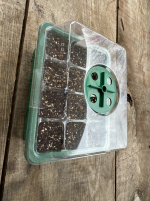Hello!
In the fall I went crazy buying and collecting different tree seeds for bonsais and to grow full size. I was at a nursery that had 3 large grafted JWP with pine cones on them. I did not know anything about the tree at the time (still very new to the hobby, and it's my first year growing trees from seed), but the trees were beautiful and I asked the nursery employee if I could have the pine cones and she said sure. When I did some research I realized how rare these seeds are but apparently in that situation the seeds are probably not viable so it killed my excitement. I did decide to go ahead in soaking and planting them because I had some extra space. I got around 45 seeds that sank and the rest floated. I planted most up in 2 mini greenhouses in seed starting mix and left them on my porch with the rest of my mini greenhouses to cold stratify (added a photo of the mini greenhouse). I had a few leftover that I just stuck in the fridge and a couple weeks ago I decided to check if there is any life to them and just stuck a couple in a tiny pot on a heat mat and to my surprise they sprouted (see below). At this point should I bring the greenhouses in and let them get a head start on the season (zone 6) or is it too early and just let them do their thing outside. And once they have a few sets of needles how big of a pot should I put them in and what kind of soil has the most success for them? I would like to keep a few for bonsai and a couple for in ground planting.
I do not intend on keeping a lot of them if they sprout. I am looking for a new job so I am likely to relocate and will probably not have space for all the trees and seedlings. So if anyone lives in East Tennessee or SW Virginia and has any interest in JWP seedlings I would be more than happy to give some away (of course if the rest sprout knowing my luck the only two I tested were the only viable ones). I know they could have cross pollinated with something else so can't guarantee purity or anything like that, but I do not plan on charging anything for them passing on the kindness since the nursery employee let me have them. Also have different varieties of trees good for bonsais in the other mini greenhouses, any extras of those I would be more than happy to give away as well.
Any advice on growing these beautiful trees or seedlings in general is appreciated.
Thank you!
In the fall I went crazy buying and collecting different tree seeds for bonsais and to grow full size. I was at a nursery that had 3 large grafted JWP with pine cones on them. I did not know anything about the tree at the time (still very new to the hobby, and it's my first year growing trees from seed), but the trees were beautiful and I asked the nursery employee if I could have the pine cones and she said sure. When I did some research I realized how rare these seeds are but apparently in that situation the seeds are probably not viable so it killed my excitement. I did decide to go ahead in soaking and planting them because I had some extra space. I got around 45 seeds that sank and the rest floated. I planted most up in 2 mini greenhouses in seed starting mix and left them on my porch with the rest of my mini greenhouses to cold stratify (added a photo of the mini greenhouse). I had a few leftover that I just stuck in the fridge and a couple weeks ago I decided to check if there is any life to them and just stuck a couple in a tiny pot on a heat mat and to my surprise they sprouted (see below). At this point should I bring the greenhouses in and let them get a head start on the season (zone 6) or is it too early and just let them do their thing outside. And once they have a few sets of needles how big of a pot should I put them in and what kind of soil has the most success for them? I would like to keep a few for bonsai and a couple for in ground planting.
I do not intend on keeping a lot of them if they sprout. I am looking for a new job so I am likely to relocate and will probably not have space for all the trees and seedlings. So if anyone lives in East Tennessee or SW Virginia and has any interest in JWP seedlings I would be more than happy to give some away (of course if the rest sprout knowing my luck the only two I tested were the only viable ones). I know they could have cross pollinated with something else so can't guarantee purity or anything like that, but I do not plan on charging anything for them passing on the kindness since the nursery employee let me have them. Also have different varieties of trees good for bonsais in the other mini greenhouses, any extras of those I would be more than happy to give away as well.
Any advice on growing these beautiful trees or seedlings in general is appreciated.
Thank you!


